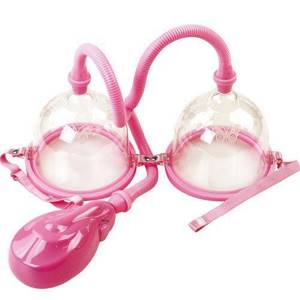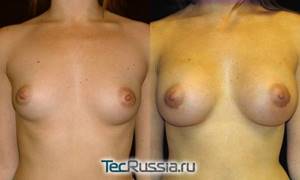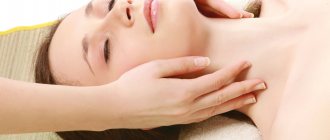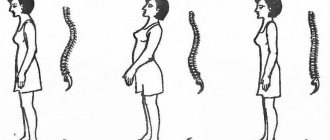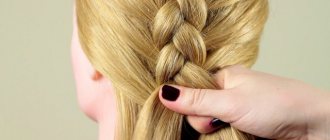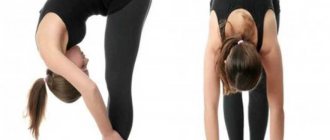There are no absolutely identical things in nature.
And there is not a single person whose both halves of the face and body along the vertical axis would be identical; there is always a difference, albeit insignificant. But if in the case of some paired organs we do not attach much importance to this, then with regard to others we often experience extreme concern. The second group includes the situation when one breast is larger than the other, and the difference reaches 1-2 sizes. Such obvious asymmetry of the mammary glands often plunges the fair sex into despair. Often, because of this shortcoming, a woman has to give up many of the joys of life - from trying on an elegant dress with a deep neckline and ending with intimate relationships.
Is this normal? Why does this happen and what to do to get back a beautiful bust with the correct proportions? Is there a health hazard? TecRussia.ru examines the issue in detail:
↑ What is breast asymmetry and what are its causes?
The roots of this phenomenon have long been studied and classified by doctors. In general, they are divided into acquired and congenital . True, getting to the root of the latter is quite difficult: it could be a matter of genetic disorders, hormonal imbalance, or intrauterine or birth trauma. Doctors still cannot say for sure why some girls’ breasts initially form incorrectly. And if in adolescence (13-16 years) it is too early to draw any conclusions, since during this period the difference in the size or shape of the mammary glands is quite acceptable, then by the age of 17-20 it should become much less pronounced. If this does not happen, then, alas, the problem itself is unlikely to “go away.”
But with acquired asymmetry, everything is much more specific. The prerequisites for such deformation are as follows:
- Pregnancy and breastfeeding is the most common reason in this group; we will discuss it in more detail below.
- Mechanical injury - moreover, the damage can be received in early childhood and forgotten over time, as a result, the blame is “shifted” to the congenital pathology.
- Concomitant pathologies of the spine – kyphosis, scoliosis.
- Breast cancer (BC) - in this case, one breast begins to enlarge as a result of a tumor growing inside it. You shouldn’t be scared and immediately attribute all your imbalances to oncology. But an examination by a mammologist will not hurt, especially since for preventive purposes it should be carried out annually in any case.
- Consequences of the operation - asymmetry can appear after any surgical intervention in the bust area. Sometimes this is an expected result - for example, with a mastectomy, sometimes it is a nuance of the rehabilitation period (uneven swelling), and sometimes it is an unforeseen complication or a consequence of a surgeon’s error.
- Hormonal changes during menopause, during menstruation or in connection with endocrine diseases.
| What does asymmetrical breasts look like? Photo: | |
| |
|
Regardless of the reasons, the defect may appear externally as:
- difference in the size of the left and right breasts. The most common, but, unfortunately, not the only option for asymmetry;
- differences in the shape of the glands - including the tubular (tube-shaped or mushroom-shaped) structure of one of them;
- different levels of location of the nipples, different diameters of the areolas, their disproportion in relation to the rest of the bust;
- severe deficiency of adipose or glandular tissue in certain areas of the mammary glands;
- uneven ptosis – when one breast sag lower than the other;
- various combinations of all of the above cases.
The good news is that all these disorders can be successfully corrected, however, treatment tactics in one case or another may differ radically.
| Ptosis and tubularity as causes of mammary gland imbalances: | |
| |
|
↑ What to do to keep your breasts beautiful when breastfeeding
During pregnancy, a woman's bust undergoes significant changes, but even greater transformations await it during breastfeeding (BF). And, alas, these changes are often not for the better: the mammary glands may increase or decrease unevenly, acquire a different shape from each other, and lose the symmetry of the location of the nipples and areolas. This “behavior” is due to a number of factors:
Hormones. During the period of bearing a child and breastfeeding, prolactin is produced in the mother’s body. When combined with estrogen, it can cause changes in the size and appearance of the bust. In addition, due to the rapid growth of tissue, the breasts often hurt, and stretch marks may appear on the skin. It is extremely difficult to completely avoid this situation; you can only reduce the discomfort and minimize the negative consequences - for this you need to select good supportive bras and be sure to use moisturizing care products so that the stretched skin does not crack and stretch marks do not form on it.
Uneven feeding: it is important to initially build the correct lactation mechanism. If the right and left breasts receive different stimulation, unequal amounts of milk accumulate in them. As a result, a difference in size appears, which often remains after the end of this process. It is important to consider and correct the following situations:
- One mammary gland regularly produces nutrition for the baby, while the other works intermittently (including this happens due to mastopathy or past injuries). As a result, the woman begins to use the “more milky” one and ignores the second one.
- During night feeding, the mother gives the baby only one breast.
- The baby, according to his “understanding,” sucks one gland well, but not the other (for example, due to differences in the shape of the nipple).
- Cracked nipples on one breast, as a result of which the woman tries to use it as little as possible.
To avoid asymmetry after breastfeeding, alternate glands when feeding, and monitor the uniformity of milk volume - express the “excess” and do not allow stagnation.
↑ When the surgeon comes into play
If one breast is much larger than the other and this is not oncology, not a feature of adolescence or an endocrine disease, the defect can only be corrected through surgery. This is a fairly popular area of mammoplasty, so today many techniques have been developed for literally any case, which differ in methods of implementation, types of access, location and models of endoprostheses, etc.
| Results of plastic surgery on asymmetrical breasts: | |
| |
|
For the patient, the big advantage is that in most cases you can choose the direction of the surgeon’s work - either enlarge the smaller breast (and, if desired, the overall bust size), or reduce the larger one. They do this in one of the following ways:
- Installation of implants. A relatively simple operation, with the help of which today almost any type of asymmetry is corrected, except for the most complex and atypical ones. Depending on the situation and the woman’s wishes, either one endoprosthesis is placed, or two, but of different volumes.
- Lipofilling is a transplantation of adipose tissue into the chest area, which is previously taken from the abdomen or sides. Advantages: the procedure is less traumatic, there is no need for general anesthesia, and your own fat, unlike implants, is never rejected by the body and does not cause the formation of capsular contracture. But this option is only suitable for a slight (no more than 0.5-1 size) increase or slight correction of shape. In addition, it is basically impossible for girls with a thin build to undergo lipofilling, since there will be nowhere to get the material for the transplant.
- Reduction mammoplasty is the reduction of one of the mammary glands. It is carried out if the bust is initially large and it is not practical to install endoprostheses to obtain the desired symmetry. The operation is complex, and, as a rule, it leaves visible scars in the lower part of the breast, but there is currently no alternative to it, and in the opinion of most patients, the final aesthetic result outweighs all the disadvantages.
- Mastopexy – breast lift. Allows you to remove asymmetry caused by uneven ptosis (sagging) of the mammary glands, which quite often happens after pregnancy and lactation. Since the volume of the bust is somewhat reduced as a result of lifting, mastopexy is usually combined with the installation of implants.
- Changes in the size and shape of the nipples and areolas. A simple manipulation that can be performed either in isolation or in combination with any of the procedures described above.
Breasts are different - causes of trouble
Before you start looking for a method to solve the asymmetry of the mammary glands, you need to understand why they began to differ in size.
Breasts are noted to be different in women breastfeeding a newborn baby. A difference in the size of the mammary glands occurs when losing or gaining weight.
The growth and formation of a paired breast organ by the age of 17-20 is considered standard, but the bust can change more than once throughout life.
Asymmetry occurs during the years of sexual development, when hormonal changes in the body often provoke the formation of different mammary glands (more often the defect is eliminated on its own).
In adult women, bust deformation occurs due to tissue atrophy and loss of volume.

Lactation contributes to the transformation of the breast due to the unequal filling of the mammary glands with mother's milk. And then the breasts differ in size, and this happens quite often.
However, if the difference is invisible to a prying eye, this is the physiological norm of a particular woman, since it is almost impossible to find mammary glands that are perfectly identical in size (they differ, albeit slightly).
The origin of innate asymmetry
The main reason why breasts are different is a congenital anomaly. Asymmetry often becomes noticeable even at the stage of growth of the mammary glands in a girl. But often by the age of 20, the dissimilarity in size turns out to be barely noticeable.
If minimizing the difference in breast size has not occurred by this age, the problem will not be solved on its own. On the contrary, hormonal changes in the female body (mainly during pregnancy) often lead to an exacerbation of problems in the form of different breasts.
Observing the formation of the bust of a girl who has entered puberty will allow you to avoid an unpleasant situation.
Acquired difference in breast volume (3 reasons)
This trouble is due to several acquired reasons:
- mechanical injury to one of the mammary glands. And then this paired organ stops developing. This happens especially often when playing sports, so you need to be careful;
- asymmetry of the breast due to diseases, for example in the form of a tumor - benign or malignant. Getting rid of them requires surgical intervention if one mammary gland is reduced due to the growth of pathological tissue in it;
- lactation, when milk accumulates unevenly in the right and left breasts and is not consumed equally by the baby from there. During feeding, the child often chooses the same breast, which is due, for example, to a different nipple shape. If there are possible cracks in one nipple, which causes discomfort, the mother prefers to feed the baby with the other breast.
In case of hormonal imbalances or suspicion of a tumor formation, you should immediately consult a doctor.
Causes of asymmetry during hepatitis B
During breastfeeding, a woman's body visually changes. The shapes become more rounded and feminine, the volume and size of the mammary glands increases. During lactation, a woman is forced to change her underwear, since the previous bras do not fit the new “milk” volumes.

Many mothers are pleased with this development of events, but there are women who suffer from the fact that their breasts have become fuller and larger. They notice that with an increase in the bust, a difference in the appearance of the mammary glands appears. One gland becomes larger than the other, one nipple is more convex, and the areola has a larger diameter compared to the neighboring one.
The main reason for this difference is that the whole person is asymmetrical. Before pregnancy and lactation, a woman simply does not notice such features. But during breastfeeding, the volume of the glands increases, and the difference becomes more obvious. There are no women with absolutely identical mammary glands. Everyone has small differences, it’s just that most mothers don’t notice them, don’t pay attention to them, or simply ignore them.
There are also more serious reasons why one breast is larger than the other when breastfeeding. This feature becomes pronounced during lactation if a woman has previously had injuries to the mammary gland or inflammatory diseases. Plastic surgery and surgical interventions to remove tumors lead to such consequences. If the mother has not had breast surgery or injuries before, then the reasons for the uneven distribution of milk are:
- anatomical features that the woman had not previously focused on;
- errors in the organization of feeding - incorrect latching, regular pumping, feeding with one “duty” breast at night;
- special behavior of the child during sucking.
Establishing the reason
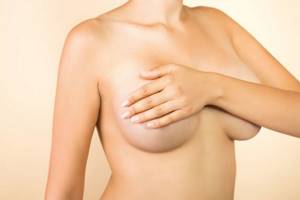
First, the reason why the breasts are different is established.
- An examination prescribed by a mammologist or gynecologist will allow you to exclude/confirm oncology. The doctor will palpate the condition of the breast and possibly send you for an ultrasound. If serious suspicions arise, a biopsy will be required, after which the doctor will plan treatment.
- If one breast has become larger than the other during lactation, strict adherence to breast hygiene will be required. The baby must be applied to the nipples of the mammary glands alternately from birth. At the same time, make sure that the baby first sucks the milk in full from one breast, and then from the second. And the expressed milk from each breast should also be of equal volume.
- Often a slight discrepancy in breast size is caused by unequal tension in the pectoral muscles. Then, in a “right-hander,” the right arm is loaded more, and the right-sided pectoral muscle works more energetically than the left-sided one and becomes larger. In such a situation, even distribution of the load will help.
After an injury or lactation period, plastic surgery will correct any asymmetry that has not disappeared. It is permissible to enlarge smaller breasts or reduce their volume, or correct the shape of both glands.
If the proportionality of the mammary glands is insignificant, it is possible to visually hide the defect with selected underwear or clothing and accessories.
Will firm breasts remain after childbirth?
During pregnancy, the breasts prepare for lactation. Under the influence of the hormone prolactin, the mammary glands swell and the breast muscle tissue weakens. With the birth of a child, the glandular lobules of the mammary glands fill with milk and stretch the skin of the breast. After the cessation of lactation, these lobules shrink, the size of the breast most often returns to its prenatal state, but its shape and elasticity often deteriorate.
To maintain firm breasts after childbirth, follow these recommendations:
- During pregnancy and after childbirth, moisturize your breast skin with special creams and essential oils (for example, jojoba oil).
- Always wear a bra, and during lactation, a nursing bra. If your breasts have greatly increased in size, wear a cotton sports bra at night.
- Avoid milk stagnation. Use a breast pump, since hand expression traumatizes the mammary gland and stretches the skin, causing it to sag.
Degrees of asymmetry

Patients who contact the clinic are offered various options for correcting breast asymmetry. First, the degree of the defect is established - mild, moderate or severe.
- A mild indicator of breast asymmetry is hardly noticeable, since the mammary glands are almost indistinguishable. The problem is “cured” by choosing the right bra.
- The average degree is characterized by the volume of one mammary gland exceeding the size of the other by 1/3. The flaw is clearly expressed even when wearing the “correct” clothes.
- In severe cases, the difference in volume is 50%, which excessively disturbs the proportions of the body.
The degree of the defect is determined based on the size of the base of the mammary glands and the distance between the nipple and:
- manubrium of the sternum;
- midclavicular line along the border of the gland;
- fold under the mammary gland.
The choice to eliminate violations is based on the asymmetry caused by:
- size and shape of glands;
- position of submammary folds;
- location and/or size of the nipple-areolar complexes;
- a mixture of breast symmetry disorders.
During your consultation, a professional doctor will find out the cause of breast asymmetry and suggest ways to eliminate it.
The best exercises for breast lift
Below you will find exercises for the elasticity of the pectoral muscles for women, which can be performed at home. Do them regularly, and you will soon notice clear improvements.
Push ups
This is one of the most popular exercises for the pectoral muscles. Push-ups help increase the volume of the muscles of the breast tissue, due to which the chest muscles regain lost tone. The deltoids and triceps are involved.
Push-ups are performed as follows:
- lie on your stomach, place your palms on the floor at shoulder level;
- tighten your abs and rise, straightening your arms;
- then go down and come up again.
It is recommended to perform three approaches fifteen times.
Lateral arm raises
These exercises for breast elasticity perfectly strengthen the muscles that are located under the mammary glands and are excellent at combating breast sagging.
- stand straight, spread your feet shoulder-width apart;
- in your right hand, which should be diagonal to the floor surface, take a dumbbell;
- Without bending your arm at the elbow, lift it above the shoulder joint to put a load on the chest;
- then return to the starting position.
Do fifteen repetitions for each arm.
Wall push-ups
This exercise qualitatively strengthens the chest muscles. This is a simpler version of push-ups, which is why it is better for beginners. This is done as follows:
- stand approximately 50 cm from the wall surface;
- place your hands on the wall so that they are level with your shoulders;
- bend your elbows, leaning towards the wall;
- Having reached the extreme point, pause for a second;
- then return to the starting position.
Exercise "Cobra"
This exercise perfectly stretches the pectoral muscles and also puts stress on the shoulders and lower limbs. Follow this algorithm:
- lie on your stomach, straighten your legs;
- Place your arms parallel to your shoulder joints;
- As you inhale, rise up and hold in the upper position for 15-20 seconds;
- as you exhale, return to the starting position.
Exercise "Tree"
This exercise stretches and tightens weakened chest muscles. You need to do the exercise like this:
- stand up straight, raise your palms and bring them together above your head;
- Raise one leg so that the foot is on the inner thigh;
- hold in this position for 30 seconds;
- return to the starting position.
If the exercise is difficult for you at first, you can use a support in the form of a wall or a chair .
Swinging movements of the arms
A fairly simple exercise, however, it perfectly loads the chest and arms and helps make them firm after childbirth or sudden weight loss. The movements are done like this:
- stand up, place your feet shoulder-width apart;
- stretch your arms to the sides, tighten your stomach and buttocks;
- make 10 circular swings of your arms, first forward, and then in the other direction.
at least four approaches a day
Dumbbell press
The exercise loads the triceps, chest, and shoulder girdle. A press that is not isolated and helps to affect several muscle groups at once.
- You need to take dumbbells or weights that replace them in both hands;
- lie on your back, spread your arms and place them perpendicular to your body;
- first raise your arms, then lower them towards the chest;
- then smoothly return to the starting position.
at least 10 reps of presses in each direction
Exercise "Triangle"
A wonderful exercise for tightening and firming the breasts, which is done as follows:
- stand straight, spread your feet shoulder-width apart;
- stretch your arms to the sides, keep them in line with the shoulder girdle;
- lean forward, simultaneously touching your left ankle with your right hand and making sure that your body looks like a triangle;
- Stay in this position for a while, then repeat the same thing, then on the other side.
Exercise "Plank"
The plank allows you to tighten your chest muscles without much effort. Additionally, it loads the abs, hips, buttocks, and core muscles.
The exercise is done like this:
- you need to take a lying position, place your arms at shoulder level, place your palms on the floor;
- raise your body so that your hands are located under your shoulder joints;
- the entire body from head to heels should be in a straight line.
- You need to stay in this position for at least 20 seconds. Then return to the starting position. The time during which you stand in the plank should be regularly increased.
There are different variations of the plank: on the elbows, on the palms, side, with the leg raised, with the arms raised, and so on. To improve the effectiveness of the complex, you can alternate different options.
Exercise "Bow"
Remarkably improves breast elasticity. This exercise is done as follows:
- you need to lie on your stomach;
- lift your legs, pull them towards the ceiling;
- supporting your legs with your hands, pull your lower limbs towards your shoulders;
- the hips and chest should be raised - only the abdominal muscles touch the floor;
- Having reached the extreme point, stay there for a while, and then return to the starting position.
Exercise "Locust"
This pose helps tighten the breasts and improves the overall silhouette. It helps strengthen the pectoral muscles and improve their tone. Another advantage of the exercise is that it can relieve cramps and discomfort during menstrual periods.
The sequence of actions will be the same:
- take a lying position on the floor, place your arms on the sides of your body, stretch your legs straight;
- clasp your fingers on your back, stretch and reach in the opposite direction so that your shoulders and chest rise and seem to hover in the air;
- pull your knees up, while burning your buttocks and thighs;
- keep your legs straight, hips shoulder-width apart;
- raise your legs and hold this position. Count to five, then inhale and return to the starting position.
Exercise "Warrior"
This exercise is done like this:
- stand straight, put your feet together;
- inhale, raise your arms up;
- the entire body should be in a straight line;
- lean forward so that your torso forms a right angle;
- as you exhale, slowly extend your left leg back so that it is level with your chest, back, and arms;
- remain in the accepted position for a few seconds;
- repeat the same for the other leg.
Exercise "Boat"
In this pose, the torso will assume the position of a boat. And in more detail its implementation looks like this:
- you need to take a sitting position, stretch your arms and legs in front of you;
- slowly raise your legs and lower your upper body back;
- hold your hips with your hands;
In addition to the chest, exercise helps tone the legs and arms.
Exercise "Recurve Bow"
A pose that helps stretch your arms, legs and chest. It's done like this:
- lie on your back, place your hands near your ears, bend your elbows;
- bend your knees, place your heels as close to your buttocks as possible;
- when lifting, inhale while supporting your torso with your arms and legs;
- hold in this position for 10-15 seconds;
- exhale and return to the starting position.
It is recommended to repeat the pose 5-10 times.
The main options for breast correction are different
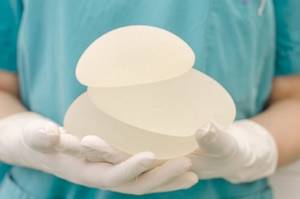
Today's medicine provides a variety of methods for correcting different breasts. And women with this problem have the opportunity to get the desired bust shape, eliminating asymmetry.
Therapeutic measures to get rid of breast asymmetry are used for mild pathology.
Vacuum massage activates blood flow, certain physical exercises will strengthen the muscle corset, due to which the mammary glands will be tightened and their shape will slightly improve.
The procedures, although with a temporary effect, still after them the breasts with a slight difference in volume become toned and without obvious signs of asymmetry. Therefore, such techniques are recommended for mandatory use.
In addition, there are such radical methods:
- Endoprosthesis replacement with the use of silicone implants for impaired symmetry of the mammary glands allows you to correct many types of imbalances, in particular tubular breasts. Depending on the state of imbalance, a breast prosthesis is installed on one or two mammary glands at once. The second option will require the use of implants of different volumes.
- Lipofilling involves taking the patient's own fat tissue from certain areas of the body, followed by transplantation of a smaller volume into the breast. The advantages of the procedure are: the hypoallergenic nature of the biomaterial, the impossibility of its rejection in the absence of capsular formation. The disadvantage of lipofilling is that: it is impossible to enlarge the breast by 0.5-1 size larger or take the required amount of adipose tissue for transplantation in patients with low body weight, there is a limited choice of breast shape, the predisposition of the taken biomaterial to resorption (this will cause a decrease in volume paired organ and/or distortion of the model).
- Mastopexy or breast lift performed in vertical, circular, T- or L-shaped and other ways. The procedure primarily eliminates mastoptosis (breast prolapse).
- Reduction mammoplasty helps reduce the volume of one of the mammary glands.
Correction of ptosis is often combined with endoprosthetics or reduction mammoplasty.
Secrets of perfect female breasts
Author Editorial Board Pravda.Ru
13.06.2007 18:41
My family
Do a simple test: place a pencil horizontally under your breasts. Is he falling? Rejoice - your breasts are in good shape. And if not? How to make breasts beautiful? There are many options, and each of them has its pros and cons.
2 shared
Secrets of perfect female breasts
Plastic
Of course, the most efficient method of improving breast shape is plastic surgery. Surveys show that 90% of young women today are ready to resort to this method if they carefully choose a good clinic, a professional surgeon, and high-quality implants. But really, is it worth going under a scalpel unless absolutely necessary? Everyone already knows about possible complications, and the result is not always pleasing: you have to subject yourself to repeated operations.
“Wearing” artificial breasts is difficult, and besides, it’s not fashionable! Many show business stars have refused implants. The most telling example is Pamella Anderson. And not all men are delighted... But if you still decide to have surgery, be prepared to pay about $10,000 for the “breast of your dreams.”
It’s a shame, but Mother Nature has left us little chance of changing the bust shape given to us by nature. But some things can be corrected without resorting to surgical interventions.
Visual illusion
The easiest way is a push-up bra. Today we are offered all kinds of overlays and “enlarging” bodices, which look very impressive under tight blouses.
When choosing a bra, keep in mind that it should fit snugly to the body, without leaving any marks on the skin or restricting movement. A bra is too big if its clasp is too high on the back, and, conversely, too small if you can’t get your finger under it. Busts hang over the cups - take a size larger. You shouldn't give up your bra, even if you're size 1. Well, if you don’t support a large bust, the skin on it will stretch and it will be very difficult to restore its elasticity.
It is also worth remembering that the push-up option is only good for coquetry. After being exposed, in both senses of the word, your fan may feel cheated.
Diet for breasts
Every kilogram of weight gained increases breast weight by 20 grams. And vice versa, if you have lost 10 kg, then each breast will lose about 200 g. If you consider that the “average” breast weighs approximately 400 g, then it is clear that the breasts will sag. Therefore, you need to lose weight gradually and feed your breasts regularly. For example, like this: before going to bed, eat 30 g of chicken or fish and wash it down with the juice of one orange or lemon. A little protein and a vitamin “bump” help increase the amount of collagen, and therefore help the process of rejuvenation of connective tissues. In addition, drink at least two liters of water, herbal tea, and fresh juices diluted with water every day. But the popular belief that cabbage makes breasts grow is nothing more than a myth.
Water treatments
A cold shower not only improves blood circulation and strengthens blood vessels, but also makes the breasts firm and prepares them for further care. By the way, high temperatures in the breast are generally contraindicated: it provokes loss of tone and sagging skin. And therefore, lovers of steaming should avoid very hot baths.
But contrast compresses, which can be done once a week, will make your breasts firm and your skin elastic. You will need two basins (with hot and cold water) and a terry towel. Dissolve 1 tsp in hot water. sea salt, and in cold - 1 tsp. lemon juice. Soak a towel in hot water, wring it out and place it on your chest for 30 seconds. Then remove and wet the towel in cold water, wring it out and put it on your chest again, this time for 1 minute. Repeat the procedure 5-6 times. The last compress should be cold. So, hot water cleanses the skin, opens pores, relaxes muscles, while cold water tones well.
Massage
Many young ladies wonder whether it is possible to correct the shape and tone the breasts with the help of massage. The answer is yes. Massage is one of the most effective methods of maintaining elasticity and velvety skin.
It is preferable to avoid massage with strong pressing movements, as it can harm your breasts. The simplest and most effective is aqua or hydromassage, that is, massage with water. It is necessary to make circular movements (at least 10 on each side), smoothly directing the stream of water from bottom to top, and then to the armpits. The most important thing here is the regularity of the procedure. It is advisable to carry it out
Secrets of perfect female breasts
every morning or at least 3-4 times a week. This is the only way you can achieve results: tighten the pectoral muscles, improve local blood circulation, increase metabolism in cells and tissues.
Cosmetics for the décolleté area
Tonics, gels, creams, masks, wraps well tighten, strengthen, smooth the skin and eliminate stretch marks. These products should be applied at least 2 times a day with upward massage movements from the center of the chest to the chin, including the neck and décolleté. If there is no special preparation at hand, it can be replaced by an intensive body cream with strengthening substances, vitamins and herbal extracts. For example, creams containing soy, horsetail, ginseng, hops, and mint help very well. You need to keep bust products in the refrigerator to enhance their toning and firming effect.
Here is a recipe for a mask to prepare at home: mix cottage cheese with olive oil and egg or sour cream and honey, apply the resulting mass on your chest for 20 minutes, and then rinse off.
Exercises for tone
The pectoral muscles, on which the mammary glands are “suspended” like springs, can be pumped up. To begin with, “make friends” with morning exercises. Any arm movement reminiscent of rowing or playing catch will work. Remember also that correct posture is one of the essential conditions for a “raised” bust.
Now about strength exercises. Are they effective? When it comes to breast augmentation, the answer is mixed. Suppose you have never purposefully worked the pectoral muscles before, i.e. They are weak and unexpressed. In this case, as a result of targeted training, you will be able to slightly round your chest, make it toned and firm. Myostimulatory devices work in a similar way, causing your muscles to contract in a state of relative rest. But don't expect to increase more than 0.5 sizes. If you start doing barbell push-ups, actively stimulating your chest muscles to grow, you run the risk of getting masculine shapes, although visually your chest will become more convex.
Here are some exercises to tone your breasts. They need to be done every day, finding time either in the morning, or after work at night.
1. Interlocking fingers. Stand straight with your feet shoulder-width apart. Raise your arms bent at the elbows to face level. Interlock your fingers tightly. Then, with sharp movements, try to spread your arms to the sides. Repeat the exercise 10-12 times.
2. Lying on your back, extend your arms up, connecting the dumbbells parallel to each other, elbows slightly bent (arms resemble a semicircle). Spread the dumbbells to the sides, with your little fingers pointing straight down so that the dumbbell falls perpendicular to the floor (inhale), then slowly return your hands to the starting position (exhale). Repeat 8-12 times.
3. Push-ups. Standing on your knees or on your toes (depending on your level of fitness) in a lying position, hands shoulder-width apart, palms facing inward at an angle of 45 degrees, do push-ups from the floor 8-15 times.
Discuss
Diet topics
Indications and contraindications
The procedure is indicated for healthy patients after undergoing a full medical examination, including a mammologist.

Correction of asymmetrical breasts using a scalpel is unacceptable in patients who have been diagnosed with health problems caused by the pathologies listed below.
CONTRAINDICATIONS
- diabetes;
- cardiovascular diseases;
- oncological diseases;
- pregnancy and lactation (the period from the end of breastfeeding to surgery on healthy mammary glands is six months).
Whether it is advisable to perform mammoplasty is decided by a plastic surgeon during a consultation.
If the decision is positive, the surgeon will take anthropometric measurements, select an implant (in case of enlargement of the smallest mammary gland) and specify the location of the endoprosthesis.
Even before the surgical procedure, the patient has the opportunity to see the planned result using computer breast modeling.
The doctor will definitely tell you about possible risks and post-operative unpleasant manifestations. And this is the displacement of the implant, the development of capsular contracture, the appearance of scars, skin necrosis and hyperpigmentation.
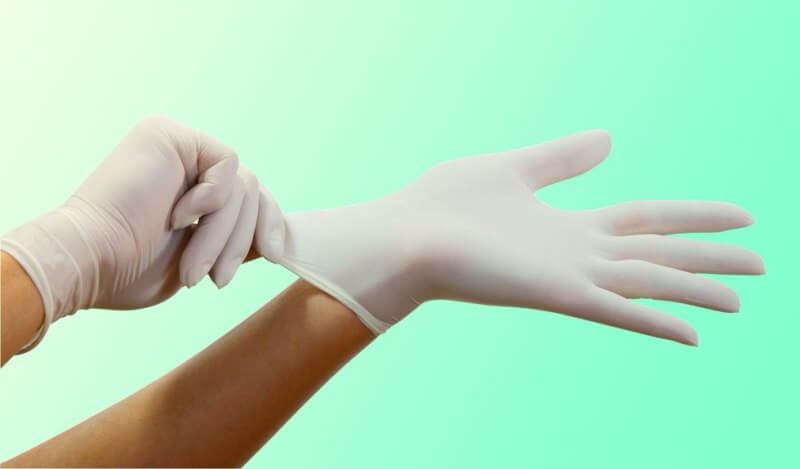
In over 90% of surgical interventions performed to eliminate obvious breast asymmetry, a positive result is achieved. The remaining percentage includes operations performed a second time.
Expert opinion

Elsa Borodina
plastic surgeon
I would like to note that with lipofilling of the mammary glands, about 30% of the transplanted fat survives. That is why it will take about 2-3 procedures to achieve the desired result.

Irina Dorofeeva
practicing cosmetologist
According to statistics, 80% of women have breasts that differ in size, which is often not even noticeable. But there are situations with obvious asymmetry. Some girls experience poor development of glandular tissue. This condition is called hypoplasia, and the pathology is corrected surgically. But there is a completely different situation when the glandular tissue rapidly grows (macromastia). In this case, the help of a mammologist is needed to determine the cause and prescribe further treatment.
Every girl/woman is not alien to aesthetic perfection, and breasts of different sizes do not make her attractive. But when correcting a deficiency, it is important to exclude serious problems with asymmetric mammary glands.
Experts call breast asymmetry the difference in volume, size, shape and location of the mammary glands. This anomaly can be congenital or acquired.
How to make your breasts firmer and more beautiful
IT IS IMPORTANT TO KNOW! Bad breath is a consequence of parasites. They will come out if you drink a spoonful.
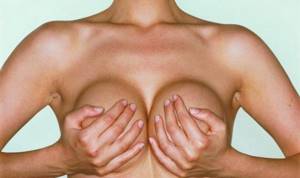
Beautiful breasts are the cherished dream of every girl who takes care of her appearance and takes care of her own health. For various reasons, the décolleté area may lose its former youth and beauty, thereby causing certain complexes and self-doubt. Most often, women encounter this problem after 30–40 years, when the skin becomes less elastic. It was during this period that beauties begin to ask questions about how to make their breasts firmer and what cosmetic procedures can stop the aging process of the skin.
Of course, if you are not a supporter of radical methods of bust correction that involve surgical intervention, then achieving the desired ideal shape in this case is extremely difficult. However, even in such a difficult situation, you can use several effective methods that will help make the piquant neckline more seductive and perfect.

Types depending on changes in bust shape
- Normal development of one of the glands and hypoplasia (underdevelopment) of the other;
- Breast development problems;
- Hyperplasia (excessive development) of one of the breasts;
- An increase in the volume and change in the shape of the mammary gland against the background of normal development of the other, the possibility of drooping of the larger of the breasts;
- Bilateral asymmetry;
- Impaired development of muscle tissue, bone tissue in the chest area, and the breast itself;
- One- or two-sided ptosis of the bust with a violation of symmetry;
- Extension of the chest into a tube shape (tubularity). May be accompanied by changes in size;
- Asymmetry of the position of the areola (pigmented area around the nipple), changes in its parameters and direction of the nipples (as well as their location at different levels).
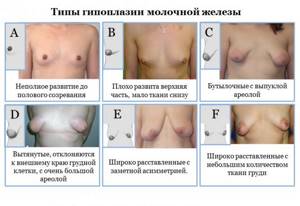
Types of breast hypoplasia
Causes
The most common causes of bust asymmetry include:
- Hereditary predisposition;
- Underdevelopment of glandular tissue;
- Incorrect breastfeeding technique, untimely expression of milk, cracked nipples. After finishing feeding it usually goes away;
- Disturbed hormonal balance, hormonal changes during menopause or during adolescence;
- Recent surgery to enlarge the bust;
- Burns and other injuries;
- Some diseases, for example, mastopathy;
- The presence of neoplasms and cancer (requires an immediate visit to a doctor).
Correction
If one breast is lower or higher than the other, or there are differences in the parameters, shape and volume of the bust, surgical intervention may be performed to eliminate these defects. The following methods of surgical correction of thoracic asymmetry exist:
- Enlargement with unilateral underdevelopment. To do this, the surgeon installs an implant that meets the normal parameters;
- Decreased with excessive unilateral development. Reduction mammoplasty is performed to reduce the parameters of an excessively large gland to normal levels;
- Tightening when lowering. The surgeon performs an intervention that lifts the bust to a normal level and improves its shape and volume;
- Bilateral implantation. If the asymmetry is bilateral, it is possible to install two implants that will correct the problems of each gland;
- Simultaneous lifting and unilateral implantation;
- Correction of the areola and nipple area. The surgeon surgically normalizes the shape, position and other parameters of the nipples and areolas.
The intervention is performed under general anesthesia; the techniques are selected (and, if necessary, combined) by a specialist based on the patient’s problems. Depending on the type and scale of the operation performed, it can last from 1.5 to 4 hours.
There are also non-surgical techniques that help mask asymmetry or even eliminate it completely:
- Camouflage bra with pads in cups of different sizes;
- Physical exercises selected by an experienced trainer sometimes help make the bust more symmetrical;
- In some cases, vacuum massage is effective;
- While breastfeeding, pumping and learning proper feeding techniques can help.
Homemade female breast corrector
Isn’t it a shame if a friend or acquaintance has lush and beautiful breasts? There is a way out!!!
This is not like silicone prostheses, gels and hormonal creams, which will subsequently affect your health. We offer you a completely harmless, unique method for increasing a woman’s bust by 1-2 sizes, for adding firmness and correcting asymmetrical breasts, if one breast is larger than the other, as well as for losing weight and restoring elasticity after breastfeeding - this is a 100% guarantee of success.
It is known that the main factor in breast deformation is the deterioration of blood flow to the mammary glands, which entails a weakening of the breast tissue. A vacuum breast corrector will help you quickly and without harm to your health to restore the lost shape of your breasts and increase their size.
Method for manufacturing a vacuum breast corrector
Take a plastic lemonade bottle (1.5 liters) and cut off the top (see Fig. 1). Then stick a rubber gasket onto the cut part. The gasket ensures a tight fit of the neck to the body, which is necessary to create a vacuum.
As a material for making a gasket, you can use an old inner tube from a children's bicycle. Cut an even piece 2 cm wide and length corresponding to the neck.

Apply Moment glue and glue it to the evenly cut part of the neck, bending both ends (1) (see Fig. 2).
Then take a bottle cap and make a hole in it. Insert the fitting into this hole. As a fitting, you can use the tip of a ballpoint pen or any other suitable part (2) (see Fig. 2).
Then cover the joint with plasticine or, better yet, seal it with melted foam. This is necessary to create a seal so that air does not pass through.
Next, take an ordinary bulb (4) and connect it to the neck through the fitting (2) using a hose (3).
The vacuum breast corrector is ready for use (see Fig. 3).
A clear example is shown in Fig. 4 (on the left - what the breasts were like before using the vacuum corrector, and on the right - how beautiful and lush the breasts became after using the vacuum corrector).
Vacuum breast enlargement method
In 1983, Dr. L. Fotina developed a method for correcting the mammary glands by exposing them to negative local effects. To do this, the breasts are placed in mini-pressure chambers connected to a discharge pump.
Low blood pressure causes increased blood flow to the mammary glands, improved delivery of oxygen and nutrients, increased metabolism in the breast area and, as a result, an increase in its volume.
Sessions of 10-15 minutes are carried out in the second phase of the monthly cycle, 10 days before the start of menstruation. The entire course lasts 3 months (30 sessions).
The method is most effective for women aged 18-35 years, when the breasts increase by 1-2 sizes.
It is not advisable to start breast enlargement earlier, since the mammary glands are still growing. After 35 years, the effectiveness of the method decreases significantly. In this case, the breasts should be enlarged with the help of special exercises.
Contraindications for use
The presence of any lumps in the mammary glands, tumors of various locations, the presence of any acute or exacerbation of gynecological diseases, acute febrile diseases, as well as diabetes, tuberculosis, ulcers and other serious diseases. For more details see V.I. Belov “Life without drugs” - “KSP”, Moscow, “Respex”, St. Petersburg, 1994.
Dr. L. Fotina's bust enlargement method involves the use of a vacuum pump, the cost of which is very high. Therefore, alternative options for creating subatmospheric pressure near the surface are proposed.
METHOD 1 (see Fig. 1). The funnel (1a) is pressed against the body (5) with its wide neck. The socket (3) of the hose (4) of a conventional vacuum cleaner is put on the narrow part of the funnel (1b) and pressed against the shock absorber-seal (2), which can be cut from soft rubber 1-2 cm thick. After turning on the vacuum cleaner, a pressure below atmospheric. The funnel (1) and bell (3) must fit snugly against the body (5) and shock absorber (2), respectively.
METHOD 2: Take a new rubber plunger (for cleaning sinks). The handle is removed. The rubber part of the plunger, which is a rubber bowl, allows you to create sub-atmospheric pressure inside the body. To do this, the plunger is pressed tightly to the body and, by pressing with the fingers, is compressed to remove some of the air from the rubber bowl - according to the principle of a vacuum suction cup. A description of the principle of influence, conducting sessions and limitations is given in the methodology.
